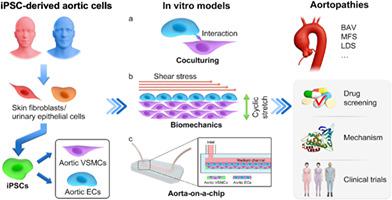当前位置:
X-MOL 学术
›
Stem Cells Transl. Med.
›
论文详情
Our official English website, www.x-mol.net, welcomes your feedback! (Note: you will need to create a separate account there.)
Modeling aortic diseases using induced pluripotent stem cells
STEM CELLS Translational Medicine ( IF 6 ) Pub Date : 2020-11-12 , DOI: 10.1002/sctm.20-0322 Kai Zhu 1, 2 , Wenrui Ma 1, 2 , Jun Li 1, 2 , Yu Shrike Zhang 3 , Weijia Zhang 1, 2, 4, 5 , Hao Lai 1, 2 , Chunsheng Wang 1, 2
STEM CELLS Translational Medicine ( IF 6 ) Pub Date : 2020-11-12 , DOI: 10.1002/sctm.20-0322 Kai Zhu 1, 2 , Wenrui Ma 1, 2 , Jun Li 1, 2 , Yu Shrike Zhang 3 , Weijia Zhang 1, 2, 4, 5 , Hao Lai 1, 2 , Chunsheng Wang 1, 2
Affiliation

|
Induced pluripotent stem cells (iPSCs) offer an effective platform for studies of human physiology and have revealed new possibilities for disease modeling at the cellular level. These cells also have the potential to be leveraged in the practice of precision medicine, including personalized drug testing. Aortic diseases result in significant morbidity and mortality and pose a global burden to healthcare. Their pathogenesis is mostly associated with functional alterations of vascular components, such as endothelial cells and vascular smooth muscle cells. Drugs that have been proven to be effective in animal models often fail to protect patients from adverse aortic events in clinical studies, provoking researchers to develop reliable in vitro models using human cells. In this review, we summarize the patient iPSC‐derived aortic cells that have been utilized to model aortic diseases in vitro. In advanced models, hemodynamic factors, such as blood flow‐induced shear stress and cyclic strain, have been added to the systems to replicate cellular microenvironments in the aortic wall. Examples of the utility of such factors in modeling various aortopathies, such as Marfan syndrome, Loeys‐Dietz syndrome, and bicuspid aortic valve‐related aortopathy, are also described. Overall, the iPSC‐based in vitro cell models have shown the potential to promote the development and practice of precision medicine in the treatment of aortic diseases.
中文翻译:

使用诱导多能干细胞模拟主动脉疾病
诱导多能干细胞 (iPSC) 为人类生理学研究提供了一个有效平台,并揭示了在细胞水平上进行疾病建模的新可能性。这些细胞也有可能在精准医学实践中得到利用,包括个性化药物测试。主动脉疾病导致显着的发病率和死亡率,并对医疗保健构成全球负担。它们的发病机制主要与血管成分的功能改变有关,例如内皮细胞和血管平滑肌细胞。已在动物模型中证明有效的药物在临床研究中往往无法保护患者免受主动脉不良事件的影响,这促使研究人员使用人体细胞开发可靠的体外模型。在本次审查中,我们总结了已用于体外模拟主动脉疾病的患者 iPSC 衍生的主动脉细胞。在高级模型中,血流动力学因素,如血流诱导的剪切应力和循环应变,已被添加到系统中,以复制主动脉壁中的细胞微环境。还描述了这些因素在模拟各种主动脉病(例如马凡综合征、Loeys-Dietz 综合征和二叶主动脉瓣相关主动脉病)中的效用示例。总体而言,基于 iPSC 的体外细胞模型已显示出促进精准医学在治疗主动脉疾病方面的发展和实践的潜力。已添加到系统中以复制主动脉壁中的细胞微环境。还描述了这些因素在模拟各种主动脉病(如马凡综合征、Loeys-Dietz 综合征和二叶主动脉瓣相关主动脉病)中的效用示例。总体而言,基于 iPSC 的体外细胞模型已显示出促进精准医学在治疗主动脉疾病方面的发展和实践的潜力。已添加到系统中以复制主动脉壁中的细胞微环境。还描述了这些因素在模拟各种主动脉病(例如马凡综合征、Loeys-Dietz 综合征和二叶主动脉瓣相关主动脉病)中的效用示例。总体而言,基于 iPSC 的体外细胞模型已显示出促进精准医学在治疗主动脉疾病方面的发展和实践的潜力。
更新日期:2020-11-12
中文翻译:

使用诱导多能干细胞模拟主动脉疾病
诱导多能干细胞 (iPSC) 为人类生理学研究提供了一个有效平台,并揭示了在细胞水平上进行疾病建模的新可能性。这些细胞也有可能在精准医学实践中得到利用,包括个性化药物测试。主动脉疾病导致显着的发病率和死亡率,并对医疗保健构成全球负担。它们的发病机制主要与血管成分的功能改变有关,例如内皮细胞和血管平滑肌细胞。已在动物模型中证明有效的药物在临床研究中往往无法保护患者免受主动脉不良事件的影响,这促使研究人员使用人体细胞开发可靠的体外模型。在本次审查中,我们总结了已用于体外模拟主动脉疾病的患者 iPSC 衍生的主动脉细胞。在高级模型中,血流动力学因素,如血流诱导的剪切应力和循环应变,已被添加到系统中,以复制主动脉壁中的细胞微环境。还描述了这些因素在模拟各种主动脉病(例如马凡综合征、Loeys-Dietz 综合征和二叶主动脉瓣相关主动脉病)中的效用示例。总体而言,基于 iPSC 的体外细胞模型已显示出促进精准医学在治疗主动脉疾病方面的发展和实践的潜力。已添加到系统中以复制主动脉壁中的细胞微环境。还描述了这些因素在模拟各种主动脉病(如马凡综合征、Loeys-Dietz 综合征和二叶主动脉瓣相关主动脉病)中的效用示例。总体而言,基于 iPSC 的体外细胞模型已显示出促进精准医学在治疗主动脉疾病方面的发展和实践的潜力。已添加到系统中以复制主动脉壁中的细胞微环境。还描述了这些因素在模拟各种主动脉病(例如马凡综合征、Loeys-Dietz 综合征和二叶主动脉瓣相关主动脉病)中的效用示例。总体而言,基于 iPSC 的体外细胞模型已显示出促进精准医学在治疗主动脉疾病方面的发展和实践的潜力。



























 京公网安备 11010802027423号
京公网安备 11010802027423号